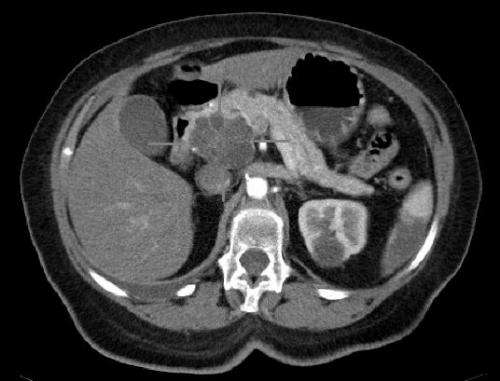New risk prediction model could identify those at higher risk of pancreatic cancer


A risk prediction model that combined genetic and clinical factors with circulating biomarkers identified people at significantly higher than normal risk of pancreatic cancer, according to results of a study published in Cancer Epidemiology, Biomarkers & Prevention, a journal of the American Association for Cancer Research.
“Pancreatic cancer is a particularly deadly cancer, with about 80 percent of patients diagnosed with advanced, incurable disease,” said the study’s lead author, Peter Kraft, Ph.D., professor of epidemiology at the Harvard T.H. Chan School of Public Health in Boston. “Catching it at an earlier stage makes it more likely that surgery will be an option, increasing the chances of survival.”
Kraft explained that existing screening techniques, such a magnetic resonance imaging (MRI), are not recommended for the general public because they may generate excessive rates of false positives. They are most appropriate for people at higher risk of pancreatic cancer, and therefore, improving identification of the high-risk population could improve tailored prevention and screening efforts, he said.
Risk factors for pancreatic cancer include family history, chronic conditions like diabetes and pancreatitis, and smoking. Kraft said prospective studies have shown that certain circulating biomarkers tied to insulin resistance have also been shown to influence risk. “These factors have been investigated individually, and in this study, we wanted to examine the combined effect of clinical factors, common genetic predisposition variants, and circulating biomarkers.”
The study examined data from four large prospective cohort studies: the Health Professionals Follow-up Study; the Nurses’ Health Study; the Physicians’ Health Study; and the Women’s Health Initiative. They analyzed data from 500 patients diagnosed with primary pancreatic adenocarcinoma between 1984 and 2010, as well as 1,091 matched controls. The study enrolled only U.S. non-Hispanic white participants, because genomic risk variants have been confirmed in the white population but not in other groups, Kraft said.
The researchers collected data on lifestyle and clinical characteristics from patient questionnaires; blood samples; and genomic DNA from peripheral blood leukocytes of the participants. They calculated a weighted genetic risk score based on data from two large genome-wide association studies.
The researchers developed three relative risk models for men and women separately. One featured only clinical factors; one added the weighted genetic risk score to the clinical factors; and the third added biomarkers proinsulin, adiponectin, IL-6, and total branched-chain amino acids.
Kraft said that each new level of data improved “model fit,” allowing for more accurate identification of pancreatic cancer risk.
Ultimately, the models identified subsets of participants who were at three-fold or higher increased risk of pancreatic cancer than the general population. The model that featured only clinical characteristics identified 0.2 percent of men and 1.5 percent of women who were at three-fold or higher increased risk. The model that combined clinical and genetic factors identified 0.3 percent of men and 2.3 percent of women at three-fold or greater risk. The model that added weighted genetic risk score and circulating biomarkers identified 1.8 percent of men and 0.7 percent of women who were at three-fold or higher increased risk. The final integrated model identified 2.0 percent of men and 2.3 percent of women who had at least three times greater than average risk in 10 years of follow-up. The individuals in the top 1 percent of risk carried a 4 percent lifetime risk of pancreatic cancer.
While this model would have to be confirmed and studied in other populations, Kraft said the study indicates that combining biomarkers with clinical and genetic factors can result in better identification of the people who could benefit from screening and early detection of pancreatic cancer.
“Like most cancers, pancreatic cancer is multifactorial,” Kraft said. “The more we are able to combine information from multiple domains, the better we will become at identifying those who could benefit from screening.”
Source: Read Full Article